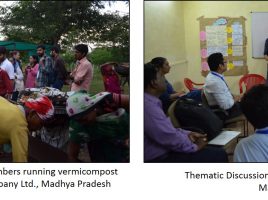Opportunities for People – Planet and Prosperity in a post COVID world
Within the first two weeks of the global and Indian lock-down, images of blue skies, clean waters and birds and wildlife teeming into city gardens and streets started emerging on social media.
In the last couple of days, what really caught my eye were images from the industrial town of Jalandhar, sent by many residents going viral on social media. The skies in Jalandhar were so clear that residents were able to see the snow clad Himalayan Mountains of the Dhauladhar range some 213 kms away from their roof tops. Elders remarked that this was last seen at least a generation back so, these views and such skies have been seen after almost 30 to 40 years.
Similarly the Yamuna river, which is like an industrial drain most of the year frothing with chemicals, a health hazard as well as poison for its fish and the nearby agriculture runs clear and blue today and you can see to its bottom.
We all know what has happened. The industries are closed down, the factories shut; no polluting effluents in the drains, no diesel bring burnt in the constantly running electricity generators and no fumes from the factory chimneys; the roads are empty of vehicular traffic and there are no petrol fuel fumes in the air, construction activity is stopped and there is no dust blowing. The rice harvest and agriculture field burning is still many months away.
But there is a flip side to this sudden breath of fresh air. Thousands of small industries are closed, tens of thousands of workers are without work, at the mercy of charity and will soon be facing penury, hunger and destitution.
Jalandhar is among the most dynamic industrial towns in north India. It has a wide variety of industries such as textiles, dyeing, paper, furniture, automotive parts, iron and steel forging, hardware etc. I looked up the data from Jalandhar district as a whole as I thought it is not just the city but also the emissions from factories around that would have an impact on air quality. According to the district industries profile (Brief Industrial Profile of District Jalandhar 2016-2017, micro small and medium industry development institute, Ministry of MSME, Government of India), there are no large scale units here. I found that in the year 2016-2017, the district had 13,815 small scale units and 6891 artisanal units. Of these approximately 9000 are those that can be classified as potentially “polluting industries”. These units (as a whole) employed approximately 159,000 people in different categories of skilled, semi-skilled and unskilled workers. Approximately 100,000 or 65% of these workers are employed in the so called polluting sectors. And, we must note that these are registered units as they are enumerated in the district industries profile. There may be as many if not more micro and nano units across the district that are unregistered, operating below the radar with or without collusion with official knowledge.
I have not done a similar broad search for the industries pouring effluents into the river Yamuna upstream from and in Delhi, where we are amazed with scenes of change so stark and so soon. But it is likely that the employment and industry situation along the river upstream from Delhi is similar to Jalandhar district; here too we have a dense small industries belt.
The District Industries Report of Jalandhar District provides a road map for the “development” of industries in the region. It is interesting to note that in this road map, besides identification of TQM trainings there is not much to indicate that interventions are to be designed for cleaning up the industries, for providing them technical support and for enabling them to meet up with the production standards necessary meet pollution and health regulations in the district and city of Jalandhar.
Clearly, there are the following issues, all well-known and well understood:
- Small scale industries are either not registered or if yes, do not follow pollution control guidelines.
- Pollution control guidelines and regulations are not adequate and need to be more stringent.
- Small scale units are unable to clean up their act for a variety of reasons, I assume these are mainly technology and finance bottlenecks and viability issues among others.
MSMEs are the economic bedrock of the country’s economy. It is here that the multitude get jobs, it is these that are the ancillary units of large industries and contribute to the GDP. Therefore from both the micro-economic and macro-economic perspectives, MSMEs are among the most significant actors for economic development of the country.
Today, this economic development is a trade-off with clean air, clean water, human and ecological health. But why should this be so? I recall not very far in the past, big hoardings from the tobacco industry praying for the tobacco farmers because the new stringent laws on public warnings on cigarette packets and higher taxes on cigarettes were hitting the profit margins of the industry and losses would have to be transferred to the farmer producers. The industry would have us believe that public health policies are in conflict with people’s livelihoods, when in fact what these are in conflict with are industry profit margins.
Human Well-being and Prosperity for All within Eco-system Limits – this is what India has committed to the world as part of the SDGs. Public health is central to human well-being and primarily a responsibility of the government. Just as public funds are directed to hospitals and medical equipment (which too we find inadequate), these funds should also be directed to implementing measures that will make production systems cleaner and safer. Safe water and clean air are cheaper and more effective ways to save lives than subsidies to private hospitals to buy land for beds that the poor will not access. These are also better use of our tax monies. For us, today, it means that our production systems must be altered such that they provide jobs and incomes to the millions, the goods and services that are needed by the millions and all of this in a manner that does not pollute our land, our air and waters.
Many of the pictures on social media that I started this article with, must be from the camera phones of people employed or engaged in some manner with these very polluting small scale industries. Why then is human health and economic growth decoupled priorities in people’s minds? Why are these not the issues and questions that citizens raise when they go to vote? Why are state and national budgets not scrutinised for where the money is being spent? These are questions that must be asked whether we are in a pre-COVID or post COVID world. The stark change in air and water quality and the reaction of the citizenry indicates that these concerns must be brought center-stage into public discourse and not remain in the realm of policy making and industry lobbying.
These pictures tell us that India post COVID -19, need not get back to Business As Usual. This is an opportunity to clean-up our act. This is the opportunity for each state to enable small scale industries to clean-up and become competitive, even as they continue to provide jobs for the millions employed here. It is an opportunity for the Central Pollution Control Board and the State Pollution Control Units to raise the bar on pollution standards – rather these should be called “clean production standards”. Incentives and penalties are both required so that MSMEs can become greener, without having to pay bribes, stay under the radar and keep poisoning the land, the air and their own children.
It an opportunity to make sure large industry houses take ownership and responsibility of their value chains and ensure that their ancillary units have access to cutting edge technology that ensures no wastes, no effluents, no pollutants. They cannot either pass the costs to the producers or to the consumers. Clean standards across the value chain must become mandatory conditions reported along with profit and loss statements and not voluntary disclosures. These must become part of company valuation and share prices.
It is the opportunity for financing institutions to see pollution as a risk to society and ecology and therefore to economy, and build in the mechanisms for “green financing”. Access to loans and finance by the small scale sector to integrate cleaner production systems must attract tax benefits. Market support for the small scale, especially clean small scale industry must be available, through preferential procurement. Clean production standards must be part of tender conditions.
It is time for technology development institutions to focus their energy and minds to the problems of the small industry. We have the best brains in our country, the Indian Institutes of Technology, the CSIR labs, the Department of Science and Technology etc. who must address these issues as a priority. R&D funds have to be directed towards this arena in a results based and time bound manner.
And finally, it the time that public health and ecological health are brought to center stage of our political discourse, it is the time that “poor people in low paid polluting jobs” are not used as fodder for votes but that they demand and are provided safer, cleaner technology and work environments. Workers will need to be up-skilled to handle new ways of production which will entail costs and those costs must come from public funds and from profits of big industry. This is certainly a more worthwhile expenditure of public funds than on religious places or grandiose statues. It is also the time to objectively assess what is it that we are producing and whether it is at all required. Some production units will need to be shut down. There will be new jobs needed and must be provided for in cleaner greener sectors of production and services. Transitions will need to be made and these will need to be just and fair and give a chance for the small scale to stay vibrant and viable.
It is time, India takes a clear headed view and firm action for a cleaner greener and yet more inclusive economy. If there is one opportunity that we should seize in a post COVID world then let this be the one.
Zeenat Niazi
zniazi@devalt.org
The views expressed in the article are those of the author’s and not necessarily those of Development Alternatives.
This blog first appeared as an editorial in Development Alternatives Newsletter March, 2021







Leave a Reply